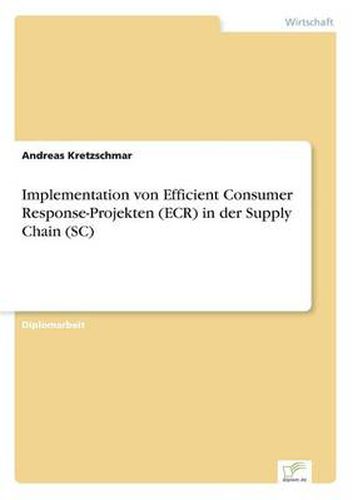Readings Newsletter
Become a Readings Member to make your shopping experience even easier.
Sign in or sign up for free!
You’re not far away from qualifying for FREE standard shipping within Australia
You’ve qualified for FREE standard shipping within Australia
The cart is loading…






This title is printed to order. This book may have been self-published. If so, we cannot guarantee the quality of the content. In the main most books will have gone through the editing process however some may not. We therefore suggest that you be aware of this before ordering this book. If in doubt check either the author or publisher’s details as we are unable to accept any returns unless they are faulty. Please contact us if you have any questions.
Inhaltsangabe: Inhaltsverzeichnis: Inhaltsverzeichnis: Vorwort Abkurzungsverzeichnis Abbildungs- und Anhangverzeichnis 1.Einleitung 1.1.Begriffsbestimmungen 1.1.1.Der Begriff ECR im Rahmen von ECR-Projekten 1.1.2.Der Begriff Supply Chain (SC) im Rahmen von SC-Management 1.1.3.Isolation des Begriffes Implementation 1.2.Problemdefinition und Zielsetzung der Arbeit 2.ECR - Entwicklung und Historie einer Kooperationsstrategie 2.1.Situation des Marktes 2.2.Die traditionellen Loesungsansatze KAM und Trade Marketing 2.3.Vom Order-Driven - zum Consumer-Demand-Driven System 2.4.Historie ECR in USA, Europa und Deutschland / ECR-Potentiale 3.Implementierung von ECR-Substrategien und ECR-Basistools 3.1.Efficient (Continuous) Replenishment Program (ERP / CRP) 3.1.1.Begriffsbestimmung 3.1.2.Notwendigkeit und Nutzen von CRP- Programmen 3.1.3.Der CRP-Implementierungsprozess 3.1.4.Die zentralen CRP-Basistools 3.2.Efficient (Store) Assortment (EA / ESA) 3.2.1.Begriffsbestimmung 3.2.2.Category Management als Schlusselfunktion von ECR 3.2.3.Die funf Phasen der Kategoriedefinition 3.2.4.Die vier Phasen des CM-Prozesses: Das McKinsey Modell 3.2.5. Space Management (SM) - Ziele und Erfolgsfaktoren 3.3.Efficient Promotion (EP) 3.3.1.Begriffsbestimmung 3.3.2. EP findet nur unzureichende Beachtung 3.3.3.Notwendigkeit und Nutzen von EP 3.3.4.Kooperatives Handling von EP 3.4.Efficient Product Introduction (Development) (EPI / EPD) 3.4.1.Begriffsbestimmung 3.4.2.Notwendigkeit und Nutzen von EPI im Rahmen der Produktpolitik 3.4.3.Kooperation in Neuprodukteinfuhrung und -entwicklung 3.4.4.Implementierung von EPI - Projekten 4.Harte (sekundare) Erfolgsfaktoren fur die ECR-Implementierung 4.1.Organisation der Unternehmung 4.2.Qualifikation des human capital 4.3.Informationstechnologie und Controlling 4.3.1.Enabling Technologies und Standards 4.3.2.Scanning und die Nutzung von Scannerdaten 4.3.3.Electronic Data Interchange (EDI) - Nutzen und Ver
$9.00 standard shipping within Australia
FREE standard shipping within Australia for orders over $100.00
Express & International shipping calculated at checkout
This title is printed to order. This book may have been self-published. If so, we cannot guarantee the quality of the content. In the main most books will have gone through the editing process however some may not. We therefore suggest that you be aware of this before ordering this book. If in doubt check either the author or publisher’s details as we are unable to accept any returns unless they are faulty. Please contact us if you have any questions.
Inhaltsangabe: Inhaltsverzeichnis: Inhaltsverzeichnis: Vorwort Abkurzungsverzeichnis Abbildungs- und Anhangverzeichnis 1.Einleitung 1.1.Begriffsbestimmungen 1.1.1.Der Begriff ECR im Rahmen von ECR-Projekten 1.1.2.Der Begriff Supply Chain (SC) im Rahmen von SC-Management 1.1.3.Isolation des Begriffes Implementation 1.2.Problemdefinition und Zielsetzung der Arbeit 2.ECR - Entwicklung und Historie einer Kooperationsstrategie 2.1.Situation des Marktes 2.2.Die traditionellen Loesungsansatze KAM und Trade Marketing 2.3.Vom Order-Driven - zum Consumer-Demand-Driven System 2.4.Historie ECR in USA, Europa und Deutschland / ECR-Potentiale 3.Implementierung von ECR-Substrategien und ECR-Basistools 3.1.Efficient (Continuous) Replenishment Program (ERP / CRP) 3.1.1.Begriffsbestimmung 3.1.2.Notwendigkeit und Nutzen von CRP- Programmen 3.1.3.Der CRP-Implementierungsprozess 3.1.4.Die zentralen CRP-Basistools 3.2.Efficient (Store) Assortment (EA / ESA) 3.2.1.Begriffsbestimmung 3.2.2.Category Management als Schlusselfunktion von ECR 3.2.3.Die funf Phasen der Kategoriedefinition 3.2.4.Die vier Phasen des CM-Prozesses: Das McKinsey Modell 3.2.5. Space Management (SM) - Ziele und Erfolgsfaktoren 3.3.Efficient Promotion (EP) 3.3.1.Begriffsbestimmung 3.3.2. EP findet nur unzureichende Beachtung 3.3.3.Notwendigkeit und Nutzen von EP 3.3.4.Kooperatives Handling von EP 3.4.Efficient Product Introduction (Development) (EPI / EPD) 3.4.1.Begriffsbestimmung 3.4.2.Notwendigkeit und Nutzen von EPI im Rahmen der Produktpolitik 3.4.3.Kooperation in Neuprodukteinfuhrung und -entwicklung 3.4.4.Implementierung von EPI - Projekten 4.Harte (sekundare) Erfolgsfaktoren fur die ECR-Implementierung 4.1.Organisation der Unternehmung 4.2.Qualifikation des human capital 4.3.Informationstechnologie und Controlling 4.3.1.Enabling Technologies und Standards 4.3.2.Scanning und die Nutzung von Scannerdaten 4.3.3.Electronic Data Interchange (EDI) - Nutzen und Ver